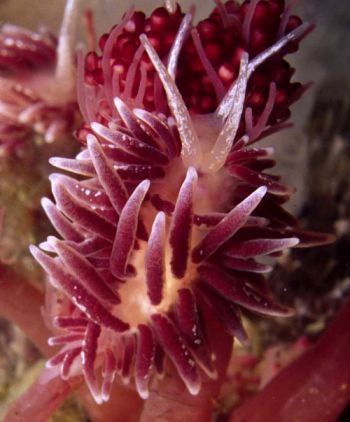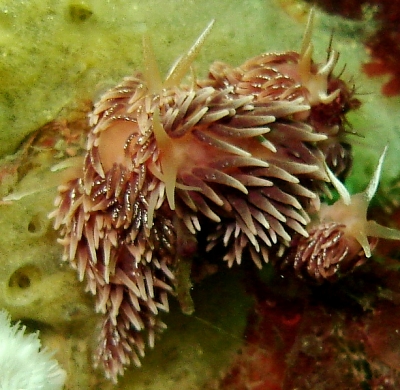
Cuthona punicea
Millen, 1986
Order: NUDIBRANCHIA
Suborder: AEOLIDINA
Family: Tergipedidae
DISTRIBUTION
Known only from British Columbia, Canada
PHOTO
Plumper Rock, near Telegraph Cove, Vancouver Island, British Columbia, Canada. August, 2001
Depth: 21 meters, Length: 12mm. Photo: Marli Wakeling
"The body is relatively stout, wider in front than behind and up to 24 mm in length. the body colour is transluscent white or pale peach, with peach ovotestis, reddish tipped jaws and small black eyes visible through the skin. The oral tentacles are long, up to 5 mm, slightly flattened and wider at their bases. The dorsal surface of each oral tentacle is encrusted with opaque white spots forming a broad line. The tentacles arise from the anterolateral corners of the head. The rhinophores are up to 8 mm long and are smooth, cylindrical, widest at their bases. All surfaces of the rhinophores are flecked with opaque white pigment spots. These spots are densest posteriorly and towards the tips, sometimes coalescing to form a line. The head is oval, not wider than the foot, with a T-shaped mouth. The cerata are elongate, cylindrical, and up to 7 mm long. They are slightly flattened proximally, have blunt, rounded tips, and contain small cnidosacs. The digestive diverticula vary in colour from dark wine-red to purple. In animals that have recently fed, the diverticula fill the cerata and give them a bumpy outline. In starved animals the diverticula appear to have short irregular knobs. The ceratal sheaths are transparent grey towards the dorsum, shading to white in the distal one-third, where there are numerous subepidermal glands. The cerata appear white tipped beyond the extension of the digestive diverticula because the glands are densest in this area. The extreme tips, however, lack subepidermal glands. In some animals the outermost third of the ceratal sheath takes on a peach-coloured hue. The cerata have a broken line of opaque white pigment, sometimes appearing as a line of spots down their outer sides. The cerata are arranged in 13-23 irregular, transverse rows. The rows are not simple but are usually paired, forming a horseshoe with the largest, innermost cerata in the center. The tall, fluted anal papilla is posterior in the interhepatic space and immediately anterior to the dorsalmost ceras in the first postcardiac row, although the anterior branch of the second postcardiac row is dorsal to it. The renal pore is slightly antedorsal to the anus. The gonopore is below the 2nd-4th rows of the right anterior hepatic branch. The foot is rounded anteriorly and triangular in shape, tapering posteriorly to a wide, bluntly rounded tail. There is a moderately large foot flange". [From Millen, 1986]
Compare with Cuthona columbiana. [= Catriona columbiana]
Reference:
• Millen, S.V. (1986) Northern, primitive Tergipedid nudibranchs, with a description of a new species from the Canadian Pacific. Canadian Journal of Zoology, 64(6): 1356-1362.
Rudman, W.B., 2003 (October 19) Cuthona punicea Millen, 1986. [In] Sea Slug Forum. Australian Museum, Sydney. Available from http://www.seaslugforum.net/find/cuthpuni
Related messages
Cuthona punicea on food hydroid
July 9, 2007
From: Marli Wakeling

Hi Bill,
Here are some shots of Cuthona punicea on it's food, Corymorpha sp. hydroid (still undescribed). What's interesting are the number of amphipods (2 different undescribed Proboloides sp.) with the glowing red eyes on the hydroids. Perhaps a bit of protein to go with the hydroid!
Locality: Broughton Archipelago, 20 metres, British Columbia, Canada, Pacific, 20 May 2007, Rock Wall. Length: 8mm. Photographer: Marli Wakeling.
Cheers,
Marli
scubamarli@gmail.com



Hi Marli,
Nice biological observation. Thanks for sharing.
The amphipods are very cool too. I know you were tongue in cheek about the extra protein, as we all know this aeolid is a highly specialized cnidarian predator. I would like to note the pinkish cnidarian (bottom left) is the octocoral, Alcyonium sp.
Thanks again,
Dave Behrens
Cuthona punicea egg masses
March 24, 2007
From: Jackie Hildering & Glen Miller

Hello Bill,
One of the challenges Glen and I have taken on is finding nudibranchs with their eggs masses. We believe that these may be those of Cuthona punicea, seen here clustering and proximity to the masses (see upper left of image). This is contrary to the literature that states that they only lay their eggs on the stalks of the raspberry hydroid (Corymorpha ).
Locality: Marg's Wall (Plumper Island Group), 40', British Columbia, Canada, Pacific Ocean, 18 March 2007, Wall. Length: 2.5 cm. Photographer: Glen Miller .
Hoping to stimulate the contribution of more egg mass photos from British Columbia.
Jackie
earthlingenterprises@telus.net



Hi Jackie and Glen,
Well I certainly agree with you that these egg masses were laid by the abundant Cuthona punicea, you observed. I also believe that the hydroid seen in the bottom of the lower photo is what Lamb and Handy (2005) and my guide refer to as the raspberry hydroid. Your poor devils shown here are simply all eaten up.
Thanks for sharing this,
Dave Behrens
Cuthona punicea from British Columbia
October 21, 2003
From: Paul Sim

Hello Bill,
Do you think this animal is the Cuthona punicea? It does appear to be in the queue for dining on the purple hydroid Corymorpha sp along with some already seated copepods, as Sandra Millen outlined in earlier dialog.
Date = Sept 2, 2003
Location = N.E. Pearse, Plumper Island Group, British Columbia, Canada
Terrain = wall
Depth = 60 feet
Temp = 50 degrees farenheit
Equip = Nikonos-V, 1:1, Fuji Superia
Paul Sim
plsim@shaw.ca
Sim, P., 2003 (Oct 21) Cuthona punicea from British Columbia. [Message in] Sea Slug Forum. Australian Museum, Sydney. Available from http://www.seaslugforum.net/find/11233
Thanks Paul,
I'm glad to get one from you I feel confident about. I am sure your id is correct. The animal looks the right colour and shape and it's on the right hydroid.
Best wishes
Bill Rudman
Cuthona punicea from Canada
July 25, 2002
From: Wendy Atkinson

This photo was sent by Wendy Atkinson in an earlier message with photos of Flabellina verrucosa. It has been identified as Cuthona punicea by Marli Wakeling, so for the sake of completeness I am posting a copy of the message here on the C. punicea page.
Bill Rudman
====================
Hi,
Can anyone help id which Flabellina these may be? Found at 40-45 feet in Hakai Pass - Port Hardy area, BC, Canada. Are they just variations on the same theme?
Wendy Atkinson
wendyatkinson@attbi.com
Atkinson, W., 2002 (Jul 25) Cuthona punicea from Canada. [Message in] Sea Slug Forum. Australian Museum, Sydney. Available from http://www.seaslugforum.net/find/7645Re: Cuthona punicea from British Columbia
June 1, 2002
From: Dave Behrens
Hi Bill:
Yes, these are classical Cuthona punicea.
Dave
dave@seachallengers.com
Behrens, D., 2002 (Jun 1) Re: Cuthona punicea from British Columbia. [Message in] Sea Slug Forum. Australian Museum, Sydney. Available from http://www.seaslugforum.net/find/7133Thanks Dave,
Bill Rudman
Cuthona punicea from British Columbia
May 31, 2002
From: Marli Wakeling

Dear Bill,
Although this animal is supposed to be quite rare, there were hundreds in the area known as the Broughton Archipelago in British Columbia. They were buried in the polyps of these 'purple mouthed' hydroids, chewing away! I have never seen them anywhere else: the nudibranchs or the hydroids.
Dive Site: Stephanson's Reef, Broughton Archipelago, British Columbia
Depth: 65 feet
Length: 7mm
Date: May 18,2002
Photograph: Marli Wakeling
Marli
scubamarli@excite.com


Thanks Marli,
I guess this is the purple hydroid that Sandra mentioned in her message.
Best wishes,
Bill Rudman
Cuthona punicea from British Columbia
October 25, 2001
From: Marli Wakeling


Hi Bill,
Here is Cuthona punicea, which I had confused earlier with Catriona columbiana. I am sending a photo of Catriona columbiana in a separate message: found a metre away from these beauties. As you can see they are on an undescribed hydroid in a deep burgundy colour.
Dive Site: Plumper Rock, near Telegraph Cove, Vancouver Island,British Columbia.
Date: August, 2001
Depth: 21 meters
Length: 12mm
Photograph: Marli Wakeling
Marli
scubamarli@excite.com
Wakeling, M., 2001 (Oct 25) Cuthona punicea from British Columbia. [Message in] Sea Slug Forum. Australian Museum, Sydney. Available from http://www.seaslugforum.net/find/5533Thanks Marli,
Well this species certainly seems to be interested in eating hydroid polyps. As I said in your other message, it would be very interesting to know if Cuthona columbiana is ever seen taking an interest in the hydroid polyps.
Best wishes,
Bill Rudman
